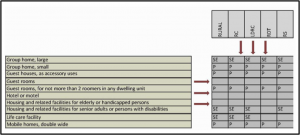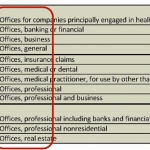Montgomery County is working to rewrite its aging and complicated zoning code. In the last installment, I discussed problems with our zones. This post looks at issues facing allowable uses.
Zoning codes determine which land uses are or are not allowed to operate in each zone. Montgomery County’s code deals with allowable uses by organizing them into tables or lists. Each zone or group of zones has a use table, list, or combination. The lack of standardized presentation of uses is part of the problem.
In each zone, uses, such as book stores, bowling alleys, recycling facilities, and townhouses, are either permitted by right or special exception, as indicated in the tables.

The use table shows uses on the left, zones on the top. Uses are permitted by right if they have a “P” and are special exceptions with an “SE”; they are not allowed if blank.
Our use tables, however, are not very user-friendly. If you know the zoning of a property, you can easily figure out what is permitted. However, if you want to know in what zone your new enterprise will fit, the tables won’t shed much light.
 Montgomery’s code lists 433 specific uses. However, many of them are duplicative, overlapping, or outdated. The code lists 18 different types of office, including “offices, business,” “offices, insurance claims,” “offices, general,” “offices, professional,” and “offices, professional and business.”
Montgomery’s code lists 433 specific uses. However, many of them are duplicative, overlapping, or outdated. The code lists 18 different types of office, including “offices, business,” “offices, insurance claims,” “offices, general,” “offices, professional,” and “offices, professional and business.”
There are nine different types of child care, three different types of antique stores, and three different listings for Christmas tree sales. Do we really need an individual use for each variation of an antique shop?

Abattoirs, blacksmiths, foundries, millinery shops, and variety stores are all listed as permitted uses. Not only did most of those uses disappear from Montgomery County a century ago, but do people really know what those terms mean?
The modern term for abattoir, incidentally, is “slaughterhouse.”
Oddities abound. Permitted uses in the I-2 (heavy industrial) zone include “stove polish” and “starch, glucose and dextrin.” The code doesn’t say the manufacturing of stove polish and starch, glucose and dextrin are permitted; it says those things are permitted. Does that mean one can use them in manufacturing? One can store them? Produce them? The code simply does not provide answers to these questions.
Like the rest of the code, our use tables are the victims of unplanned additions and amendments. As new zones were added, uses were removed, added, and modified without consideration for the overall form or goals of the code. If a use category wasn’t broad enough, often times, a new specific use was inserted. And sometimes, use categories would be amended in one place but not another.
These issues need to be addressed. However, our approach must be more than just a revision of the existing use tables. The county’s approach must be one which will deter subsequent haphazard and complicating additions or modifications. Our goal is to provide more certainty in the zoning process. Property owners, neighbors, and builders must know as much up front as possible, to help simplify the process and achieve more predictable results.
Cross-posted at Greater Greater Washington.